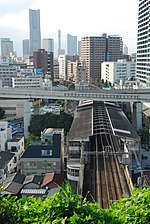Yokohama Cultural Gymnasium
1962 establishments in Japan2020 disestablishments in JapanBasketball venues in JapanBoxing venues in JapanDefunct indoor arenas in Japan ... and 7 more
Music venues in JapanNaka-ku, YokohamaOlympic volleyball venuesSports venues completed in 1962Sports venues in YokohamaVenues of the 1964 Summer OlympicsYokohama B-Corsairs

Yokohama Cultural Gymnasium (横浜文化体育館, Yokohama Bunka Taiikukan) is an indoor sports arena located in Naka-ku, Yokohama, Japan. The capacity of the arena is 5,000 people and was opened in 1962. It is a five-minute walk from the closest subway station, Kannai Station, on the JR/Yokohama Municipal Subway. The arena hosted the volleyball events of the 1964 Summer Olympics. The last major event held at the arena was an event held by Big Japan Pro Wrestling on August 30, 2020 which was called "Last Buntai". The arena closed its doors on September 6, 2020 with Yokohama United Arena set to replace this gymnasium in 2024.
Excerpt from the Wikipedia article Yokohama Cultural Gymnasium (License: CC BY-SA 3.0, Authors, Images).Yokohama Cultural Gymnasium
Odori Pkwy., Yokohama Naka Ward
Geographical coordinates (GPS) Address External links Nearby Places Show on map
Geographical coordinates (GPS)
| Latitude | Longitude |
|---|---|
| N 35.441047222222 ° | E 139.63654166667 ° |
Address
横浜文化体育館
Odori Pkwy.
232-0031 Yokohama, Naka Ward
Japan
Open on Google Maps








